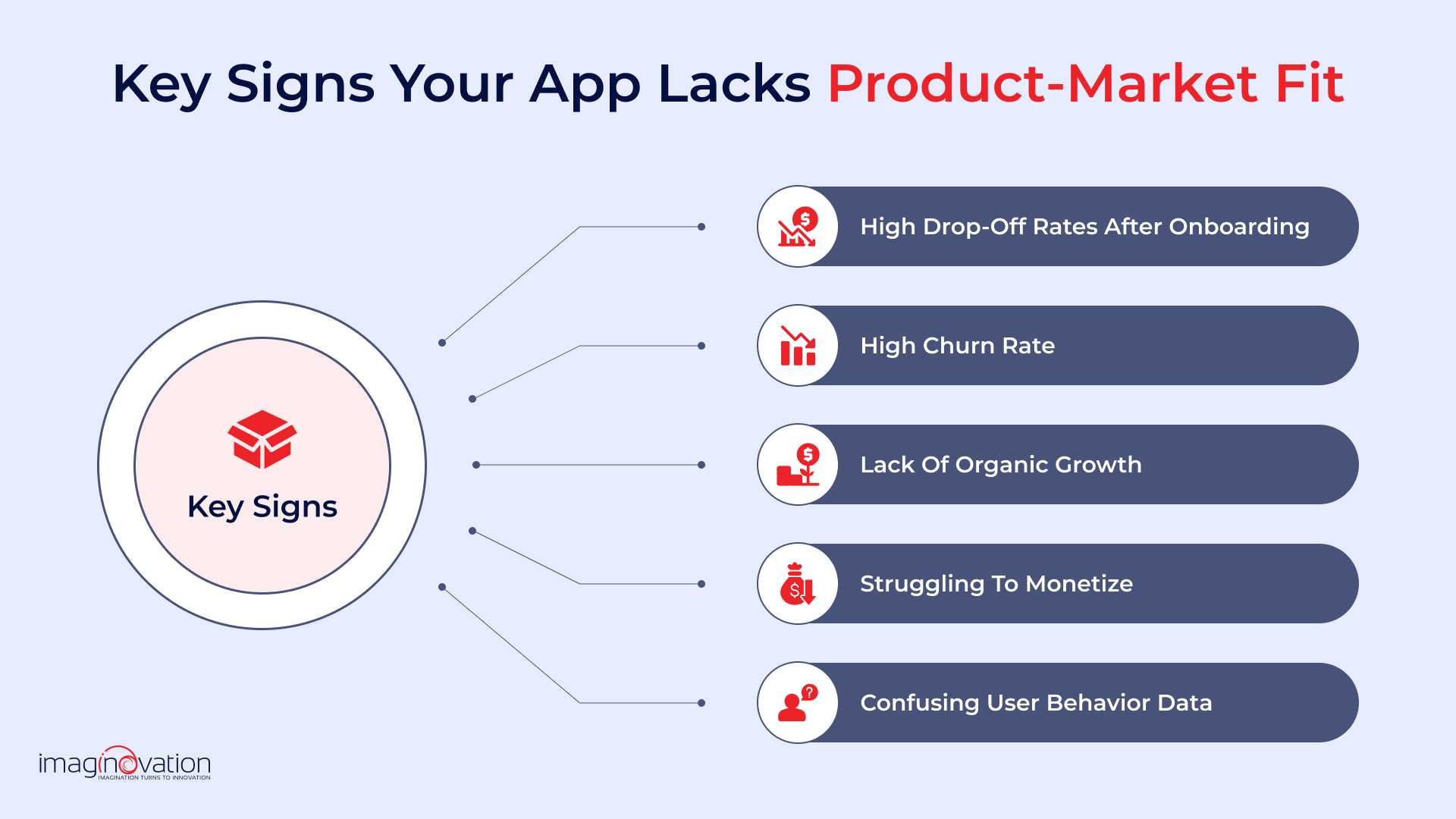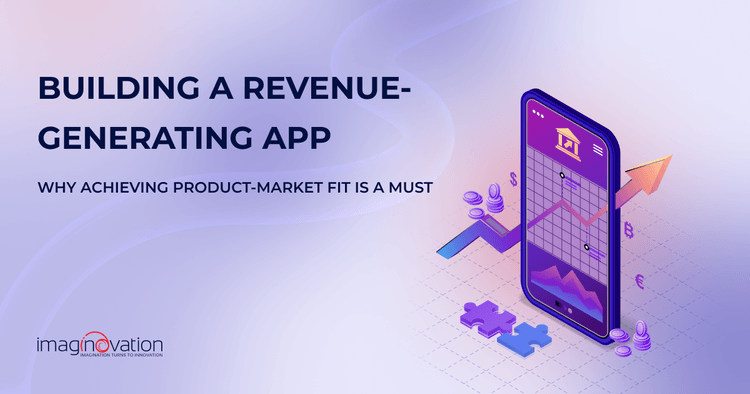Many startups fail because they don’t achieve Product-Market Fit (PMF). In fact, 35% fail due to poor PMF, second only to running out of capital (38%).
The biggest mistake? Not listening to the market.
Do you plan to build an app soon, but haven’t validated if there’s real market demand? Before investing in its development, ask yourself:
- Do customers truly want this app?
- Who are these customers?
- Has it achieved PMF?
Also, the question is, why do some digital products succeed where others fail? One reason is skipping PMF testing. Products often launch based on market assumptions.
But what exactly is PMF, and why does it matter? And most importantly, how can we achieve it?
Let’s find out!
What is Product-Market Fit (PMF), and Why Does It Matter?
What is PMF?
Product-market fit (PMF) is a critical milestone for any startup. It means your product matches what your target audience truly needs. When you get it right, growth becomes easier.

What PMF is Not.
1. PMF is not for everyone.
Your product isn’t meant to serve everyone. It must focus on a clear, well-defined market segment and solve its problem exceptionally well. If you design an app for women aged 25-35 but your branding appeals to a broader audience, you risk losing engagement.
2. PMF is not just about acquisition.
True PMF means users stay, engage, and find real value. High downloads without retention aren’t PMF.
3. PMF is not static.
Markets evolve, user needs shift, and new competitors emerge. Achieving PMF once doesn’t mean it will last forever. It requires continuous adjustments. If your new messaging app ignores user demand for a video-calling feature, you’ll lose users to competitors who adapt.
4. PMF is not instant.
It takes time and iteration to reach the right fit between product and market. Instagram, for example, started as a check-in app before pivoting to photo sharing.
Why is PMF Essential for App Success?
Achieving Product-Market Fit (PMF) does more than just align your app with customer needs. It brings major business advantages. Here’s why you should master the art of PMF for your app’s success.
1. Attracting Investors
Investors want proof that your app has real demand. PMF validates the concept behind your app, showing that users love and need your product. This validation makes securing funding easier, giving you the much-needed resources to grow and scale.
2. Enables Scalability
A product that fits the market well is built to grow. As demand for your new app rises, you can expand your operations, improve infrastructure, and ensure scalability to support more users. Without PMF, scaling efforts will lead to wasted resources.
3. Higher Retention, Less Churn
Acquiring users is only the first step—keeping them engaged is what drives long-term success. Customers who find real value in your app stick around, reducing churn and building a stable and loyal user base.
4. Strengthens Your Business Model
A successful app isn’t just about usability; it also needs a sustainable business model. PMF ensures that your pricing strategy, customer acquisition costs, and revenue streams align with market expectations.
5. Reduces Costly Pivots and Rework Post-launch
Launching an app without PMF can lead to expensive pivots and rework. These adjustments consume time and resources, often derailing your app’s progress. By reaching PMF before launch, you minimize the need for substantial changes, saving costs and reducing delays.
Key Indicators that an App Lacks PMF
Not achieving Product-Market Fit (PMF) can lead to low engagement, wasted resources, and eventual failure.
Here are the warning signs that your app hasn’t yet found PMF:
1. High Drop-off Rates After Onboarding
If users download your app but don’t return after a few uses, it’s a red flag. Successful apps keep users engaged over time. If your retention rates drop sharply after onboarding, your app isn’t delivering enough value.
2. High Churn Rate
Losing users faster than you acquire them? That clearly indicates that your app isn't solving a real need. For example, users don't find enough value to stick around if your subscription-based app has many sign-ups but few renewals.

3. Lack of Organic Growth
Apps with strong PMF grow naturally through word-of-mouth and referrals. If you’re heavily relying on paid marketing to get new users, but they don’t stay, it indicates a lack of product-market alignment.
4. Struggling to Monetize
If users aren't willing to pay for your app or its premium features, it's a sign that they don't perceive enough value. Even with a free app, engagement is unlikely to generate meaningful revenue through ads or upgrades if engagement is low.
5. Confusing User Behavior Data
If your analytics show unpredictable or inconsistent usage patterns, it could mean your app doesn’t have a clear value proposition.
For example, if users sign up but don’t interact with key features, your app may not be solving their core problem effectively.
The Risks of Skipping Product-Market Fit in Development
Skipping Product-Market Fit (PMF) in development carries significant risks, impacting both immediate and long-term business prospects. Here’s what might go wrong if you skip PMF in development.
1. Wasted Development Costs & Delays
Imagine spending months building features, only to discover no one wants them.
Without PMF, you may invest heavily in design, development, and marketing, only to backtrack later. You’ll need to fix mistakes, redesign the product, or even rebuild from scratch.
Every line of code, design tweak, and campaign costs time and money. If your app doesn’t solve a real problem, all that effort goes to waste.
Google Glass had innovative technology, but failed because everyday users did not need it. Privacy concerns, limited real-world use, and a high price made it unappealing, forcing Google to shut it down and pivot to enterprise customers.
2. High Churn & User Abandonment
If your app doesn’t solve a real problem or lacks key features, users won’t stick around, no matter how sleek it looks.
People download apps with a purpose; if yours doesn’t meet their needs, they’ll abandon it and move on. Great design and marketing can’t make up for missing functionality.
Take Quibi, a short video-streaming app, for example. Despite massive investment and high-quality content, it failed because users couldn’t share videos on social media or watch on larger screens.
Without these expected features, engagement dropped, and the app shut down in just six months.
3. Scaling Too Soon Without Market Validation
Scaling before your product truly fits the market can be a costly mistake.
Imagine pouring money into marketing, hiring, and expansion—only to realize users aren't sticking around. Early traction might look promising, but retention becomes a challenge without real demand.
If your product doesn’t solve a real problem, no amount of advertising will fix it. People will leave, and your growth efforts will collapse.
Many startups have burned through their budgets by expanding too fast, only to discover their product wasn’t ready. Instead of rushing to scale, focus on testing, refining, and listening to user feedback first.
How to Achieve Product-Market Fit in App Development

Here’s a step-by-step process to help you achieve product-market fit for your app.
Step 1 - Validate the Problem Before Writing A Single Line of Code
Before jumping into development, make sure there's a real demand for your idea. Ask yourself:
- Does your app solve a real problem?
- Can you attract potential customers affordably?
- Are people willing to pay for it?
The best way to test demand? Talk to your audience. Conduct interviews, run surveys, and research competitors to identify gaps in the market.
Next, build a simple landing page or prototype showcasing your app’s value. Add a call-to-action, like an email sign-up, and drive traffic through online ads.
Track conversions. If your rate is below 5%, tweak your messaging or layout. If there's little interest, reassess whether your app solves a pressing need.
Beyond that, make feedback easy. Set up additional channels—emails, Discord communities, or direct calls. Keep reminding users to share insights and incentivize participation if possible. The earlier you capture and act on feedback, the better your chances of success.
Step 2 - Build an MVP Focused on Core User Needs
Now, it's time to bring your idea to life. Start with a Minimum Viable Product (MVP), focusing only on essential features that solve your users' core problem.
Too many features too soon can overwhelm users and slow development. Instead, launch quickly, gather feedback, and refine as you go.
Why an MVP? It helps you test real demand, reduce risk, and optimize based on actual user behavior.
In fact, a study by McKinsey & Company found that businesses accelerating their MVP process are 1.5x more likely to exceed their goals. (Source)
Your early adopters are your best feedback loop. They’ll test, engage, and tell you what works (or doesn’t). Take their insights seriously, iterate fast, and fine-tune your product before scaling.
Step 3 - Track User Engagement & Retention Metrics
Understand how users interact with your app. Evaluate various metrics -
- Are users coming back? Track retention rates to see how many users return after their first visit. A low retention rate means your app isn’t delivering enough value.
- What features do they love? Monitor feature usage. If certain features go untouched, they might not be as valuable as you thought.
- Where do they drop off? Identify friction points. Are users abandoning the app at a specific step? Maybe the onboarding process is confusing, or a key action takes too long.
By analyzing these metrics, you can make data-driven improvements that keep users engaged and coming back.
Step 4 - Iterate, Adapt, and Optimize Based on Feedback
Building a great app is an ongoing process. Once users start engaging, their feedback is your most valuable asset.
- What do they love? Improve and expand those features.
- What frustrates them? Fix usability issues and eliminate friction points.
- What’s missing? Identify and prioritize high-value feature requests.
Fast iteration keeps users invested. When people see their feedback shaping the app, they feel heard and stick around—even if the product isn’t perfect yet.
Great apps never stop evolving. They roll out improvements, fine-tune UX, and remove unnecessary features. There’s no one perfect MVP. You may need multiple iterations before you truly nail product-market fit.
The key? Double down on what works and cut what doesn’t. Keep testing, refining, and optimizing until your app becomes something users can’t live without.
Real-World Signs That an App Has Achieved Product-Market Fit
Wondering if you've hit product-market fit? Here are the key indicators that your app may have achieved product-market fit.
- Your retention curve flattens. This means users are sticking around—an essential sign they’re finding ongoing value.
- Word-of-mouth growth kicks in. Users start recommending your app without being asked. That kind of organic buzz is a sign that you've achieved PMF.
- Your app is growing without relying on paid ads. You know there's real demand when users find you naturally, through referrals, searches, or communities.
- Engagement and retention metrics keep improving. As your app evolves, users are interacting more, not less. That’s progress.
- People request new features. Instead of abandoning the product, they’re invested and want to see it get even better.
- Your numbers back it up. Your business model is likely working when customer acquisition cost (CAC) stays lower than customer lifetime value (LTV).
Common Mistakes to Avoid When Developing for Product-Market Fit
Finding product-market fit is more than just building a great app. It’s about building the right app—something users want and will pay for.
Here are some of the most common (and costly) mistakes teams make along the way:
1. Skipping User Validation & Relying on Assumptions
One of the biggest traps? Building on assumptions.
Many teams dive straight into development without talking to real users. They assume they understand the problem and believe their solution is the answer.
But if you’re not validating your idea with your target audience, you’re flying blind. Always start with conversations, surveys, and early prototypes. Let users guide your direction from day one.
2. Launching With Too Many Features Instead of An MVP
Trying to do too much, too soon, is a common mistake that can stall progress. Overloaded apps confuse users and make it harder to learn what really works.
Adding too many features or trying to solve every use case right away can result in a bloated product that feels clunky and doesn't hit the mark with users.
What to do instead?
Start lean. Build an MVP that solves one clear problem really well. It helps you move faster, collect meaningful feedback, and iterate with focus.

3. Ignoring Feedback (Especially the Negative Kind)
It’s easy to dismiss criticism, but ignoring what users are telling you is a fast track to failure.
Product-market fit depends on listening closely and adjusting quickly. If a specific audience loves your app, dig deeper. If another group isn’t engaging, find out why—and be ready to pivot.
Also, don’t be misled by bad data. A small or skewed sample can send you in the wrong direction. Gather diverse feedback from a broad user base.
4. Scaling Too Early
It’s tempting to push marketing, fundraising, or team expansion before you’ve truly hit PMF. But without clear validation, early scaling burns resources fast and rarely ends well.
Don’t invest heavily in growth until your retention metrics stabilize, word-of-mouth kicks in, and users actively request new features. That’s when you’re truly ready to scale.
5. Building Without A Viable Business Plan
A great product isn’t enough—it needs a sustainable business model. Just because users love your app doesn’t mean it will survive financially.
Take MoviePass, for example. MoviePass, an American subscription-based movie ticketing service, offered unlimited movie tickets for a low monthly fee.
They assumed that most users wouldn’t see more than a few movies a month. Instead, subscribers flooded theaters, watching 20–30 movies monthly. The company quickly burned through cash, shut down in 2019, and filed for bankruptcy in 2020.
Conclusion
Finding product-market fit is a crucial milestone—the point when your app truly resonates with users. When your app aligns with real user pain points, you unlock traction, growth, and long-term success.
Partnering with experienced teams like Imaginovation can accelerate that journey through proven strategies and deep expertise. With the right support, your idea can evolve into a powerful, market-shaping solution.
Ready to bring your vision to life?
Let’s build something impactful—together.
Book a call with us today and take the first step toward lasting innovation.
Ready to build an app, but not sure where to start?
We've got you covered. Click the button below to get started.





